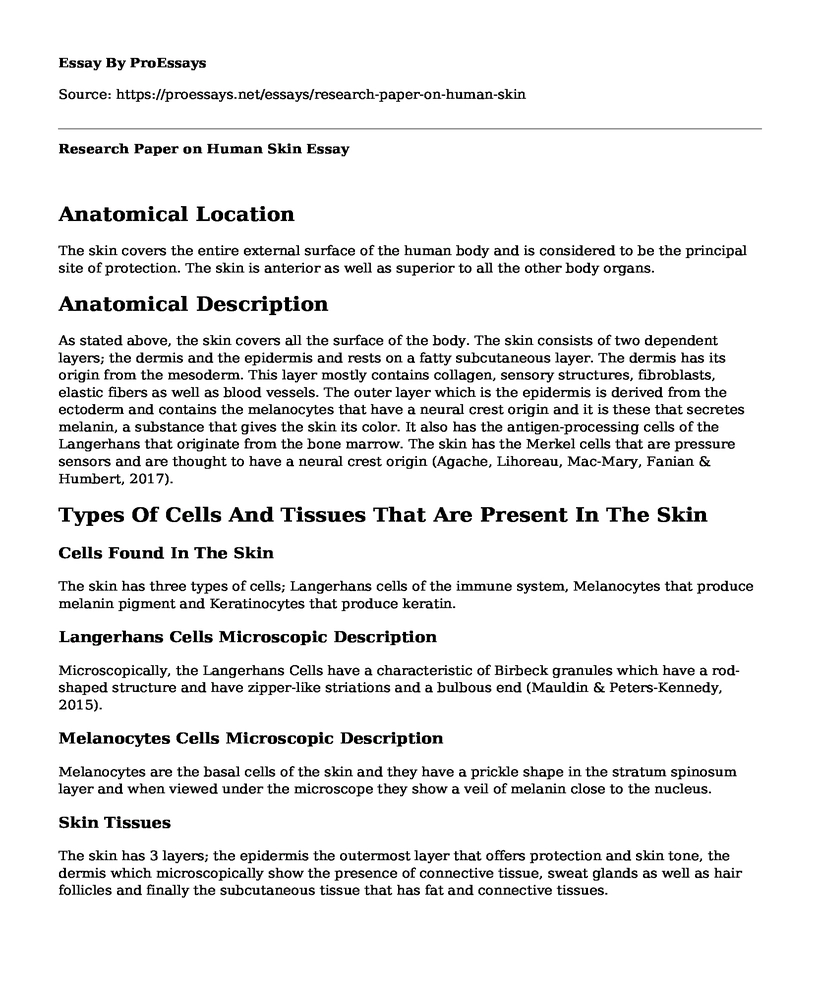Anatomical Location
The skin covers the entire external surface of the human body and is considered to be the principal site of protection. The skin is anterior as well as superior to all the other body organs.
Anatomical Description
As stated above, the skin covers all the surface of the body. The skin consists of two dependent layers; the dermis and the epidermis and rests on a fatty subcutaneous layer. The dermis has its origin from the mesoderm. This layer mostly contains collagen, sensory structures, fibroblasts, elastic fibers as well as blood vessels. The outer layer which is the epidermis is derived from the ectoderm and contains the melanocytes that have a neural crest origin and it is these that secretes melanin, a substance that gives the skin its color. It also has the antigen-processing cells of the Langerhans that originate from the bone marrow. The skin has the Merkel cells that are pressure sensors and are thought to have a neural crest origin (Agache, Lihoreau, Mac-Mary, Fanian & Humbert, 2017).
Types Of Cells And Tissues That Are Present In The Skin
Cells Found In The Skin
The skin has three types of cells; Langerhans cells of the immune system, Melanocytes that produce melanin pigment and Keratinocytes that produce keratin.
Langerhans Cells Microscopic Description
Microscopically, the Langerhans Cells have a characteristic of Birbeck granules which have a rod-shaped structure and have zipper-like striations and a bulbous end (Mauldin & Peters-Kennedy, 2015).
Melanocytes Cells Microscopic Description
Melanocytes are the basal cells of the skin and they have a prickle shape in the stratum spinosum layer and when viewed under the microscope they show a veil of melanin close to the nucleus.
Skin Tissues
The skin has 3 layers; the epidermis the outermost layer that offers protection and skin tone, the dermis which microscopically show the presence of connective tissue, sweat glands as well as hair follicles and finally the subcutaneous tissue that has fat and connective tissues.
Functions Of The Skin
The skin has three main functions which are;
- Protection - The skin offers protection from mechanical impact as well as pressure, extreme temperatures, microorganisms, chemicals, and radiation.
- Regulation - The skin regulates body temperature through sweating and is involved in the synthesis of vitamin D.
- Sensation - The skin is a sensory organ as it has an extensive network of nerves to detect as well as send variations in the environment (Rizzo, 2015).
Homeostasis
The skin plays an important role in homeostasis. The skin is known to regulate a number of aspects of physiology which include regulation of the body temperature through sweat and hair changes in the circulation system and fluid balance through sweating (Meurier, 2016).
Prediction
Defects in the receptors in the skin and the hypothalamus that senses the changes in the normal and steady environment to trigger a command from the central command (the brain) will lead to problems hence the skin will not be able to carry out its homeostasis role.
Disease
A specific disease that affects the skin is infective dermatitis. This is a skin disease that usually presents as a recurrent eczematous skin change mostly in children. Anatomically, the disease affects the nerve endings hence leading to loss of the sensory abilities. The functional changes that occur due to this disease include the loss of the sensory abilities, loss of the protective abilities and loss of the regulatory abilities. The skin will also not be able to synthesize vitamin D (Cooper, Williams, Merchant & Jones, 2016).
References
Agache, P., Lihoreau, T., Mac-Mary, S., Fanian, F., & Humbert, P. (2017). The human skin: an overview. Agache's Measuring the Skin: Non-invasive Investigations, Physiology, Normal Constants, 1-4.
Cooper, A., Williams, J., Merchant, K., & Jones, A. S. (2016). Human Anatomy and Physiology (Syllabus).
Mauldin, E. A., & Peters-Kennedy, J. (2015). Integumentary system. In Jubb, Kennedy & Palmer's Pathology: Volume 1 (Sixth Edition) (pp. 509-736).
Meurier, C. (2016). The human body. Vital Notes for Nurses: Health Assessment, 1-51.
Rizzo, D. C. (2015). Fundamentals of anatomy and physiology. Cengage Learning.
Cite this page
Research Paper on Human Skin. (2022, Jun 23). Retrieved from https://proessays.net/essays/research-paper-on-human-skin
If you are the original author of this essay and no longer wish to have it published on the ProEssays website, please click below to request its removal:
- Research Paper Example on Female Reproductive Structures
- Animal Bushmeat and Ethics Essay
- Organic Food vs. Genetically Modified Food
- Major Attributes of the Portrayal of Nature in Wordsworth's Poetry Essay
- Testing on Human Vs Testing on Animals Essay Example
- Unleashing the Power of Genetic Engineering: Exploring the Boundaries of Human DNA Modification - Essay Sample
- Essay Example on Tragic Death of Tiger Keeper Raises Questions on Captive Wildlife Space







